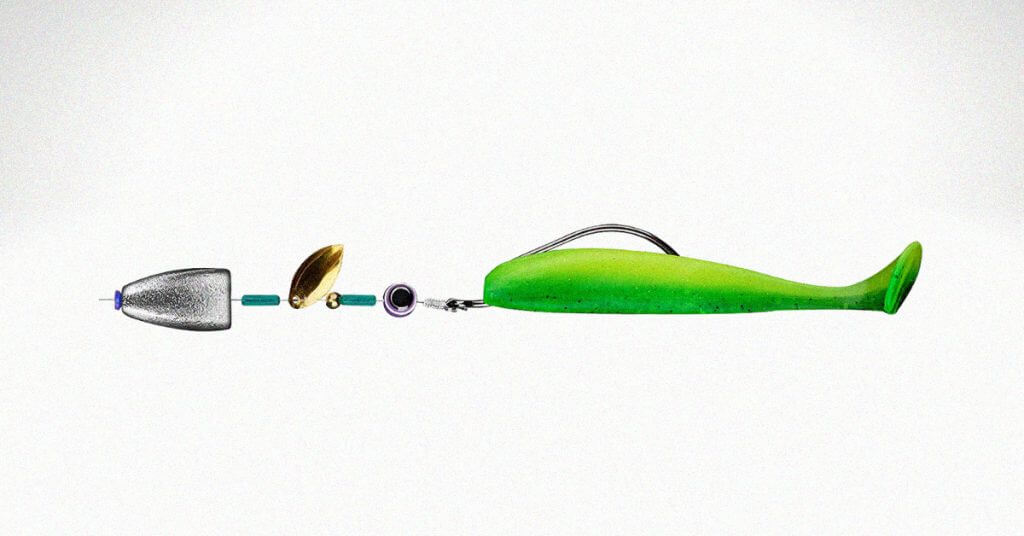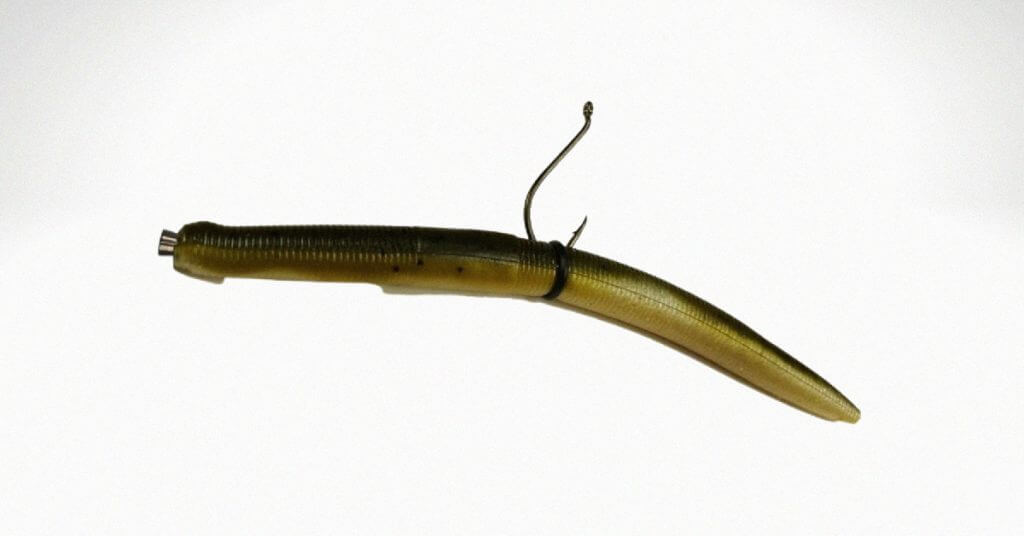The wacky rig is a unique finesse fishing style that involves hooking a soft plastic worm right through the middle.
The presentation is a bobbing and wiggling worm on the way down through the water that the bass can’t resist.
I’ve been fishing this rig for over a decade with what my dad always called his “wacko worms.”
We’d spend hours on the water every weekend with nothing else but worms, rods, and a cooler full of soggy sandwiches.
Today, we’ll learn how to rig and fish wacky style. Let’s dive in!
How to Rig a Wacky Rig

The cool thing about wacky rigs for bass is that you have a large variety of options to choose from, and you’re not limited to certain rigs for specific situations.
Wacky rigging is much more than sticking a hook through the middle of the worm and casting it out.
Here are all the different ways you can rig a worm with descriptions of how to do it the right way.
If you prefer video format – take a look at our Youtube video on the Wacky Rig!
Weightless Wacky
Wacky rig a Senko worm, and you’ll have a weightless rig that has enough weight to cast the distance.
The problem here is that people use smaller worms, and then they end up with a lightweight lure that can’t cast against the wind or anything else for that matter.
A weightless wacky rig is the simplest way you can go, and it doesn’t require much fancy knot tying or rigging knowledge.
The only unique piece of equipment you’ll need is an o-ring.
Wacky rig o-rings help you have a place to hook through the worm without having to actually puncture it right in the middle.
Here are the steps:
1. Take a standard plastic o-ring and run it to the middle of your worm
2. Use a size 1 gap hook and loop it through the hook
3. Line your hook, and you’re good to go
You don’t need any fancy fishing line for this either. A basic monofilament lined up without a fluorocarbon leader always does the trick for me.
Drop Shot Wacky Rig
If you’re looking to get technical and you’re serious about bass angling, you’ll want to wacky rig a drop shot. This rig is incredible, and it works beautifully with the finesse style of fishing we’re doing. You’ll give the worm a perfect wobble, which helps you create the best presentation when working the worm towards the bottom.
Here’s how you set it up:
1. Rig a standard drop shot with a swivel and weight at the end
2. Run your hook through the meatier part of the worm (usually about ¼ of the way down)
3. Line it up, and you’re ready to go
The main thing that defines a wacky rig compared to others is the fact that it’s not weedless, and it punctures right through the worm unless you’re using an o-ring. While it’s a bit challenging to fish the bottom with exposed barbs, it’s much easier to get a solid hook set.
Weedless Wacky Rig
So, if you’re not smitten on fishing with a fully exposed hook, I get it. I’m not a huge fan of it either. I always prefer to use some form of weedless rig whenever possible. You can take a weedless jig head and use that to puncture the worm with your standard wacky rig setup.
For this one, you’ll just follow the first rig we talked about, and you can use an o-ring if you want, but you don’t have to. You can stick the weightless jig head right through the worm, and the extra weight will help the worm sink faster.
It will create a bobbing and wiggling motion on the way down, and this is where most bass will strike.
Nail Weight Wacky
Taking a nail and driving it through the top of a Senko worm is called a lot of different things. Some call it a Neko Rig, some call it a chicken rig, others call it a Ned – I guess it depends on where you live or how you fish.
Right now, we’re called it a nail weight wacky setup, and it goes something like this.
1. Take your worm (needs to be around 7 inches and pretty thick)
2. Drive a nail weight into the meaty head of the worm
3. Wacky rig in the fat sack with your size 1 hook
The reason this rig works so well is that the weight on the top of the worm isn’t too big to become a distraction, but it allows the worm to stand up and wobble as you move along the bottom.
How to Fish a Wacky Rig
Fishing with this rig is simple. It’s a finesse angling style that requires a lot of movement on your part and a steady and active retrieval. Personally, I like a dynamic fishing style because it never feels like you’re just sitting there and waiting for something to happen.
For example, if you’re using a standard wacky rig and you’re trying to fish deep vegetation, you’re in for quite a struggle. You’ll get hung up all day, likely lose your worm, and never catch anything.
Wacky is a finesse angling style intended for a bit deeper and more clear water. You’ll fish towards the bottom, and most of the time, the bass will strike the worm on the way down.
The strategy usually includes casting out, letting the worm sink down, and create its action on its way down. Retrieving it a bit towards the middle of the water, and letting it sink back down again.
Gear Required for Wacky Rig
Let’s talk now about the gear you’ll need to fish this style. Once again, I believe in not overcomplicating something that’s incredibly simple. This rig is basic, so the gear you need is basic.
Your Rod/Reel
Whenever we’re fishing a finesse style, you’ll always want to use a spinning rod and reel combo. These work best because they give you the best touch and the most sensitivity to feel each nibble. Go with a light tackle fast action, and you won’t miss a single detail.
The Hooks
The wacky style has its own hooks, and they’re called wide gap hooks. They’re a bit more expensive than your standard size 1 hooks, and you don’t necessarily need to get them, but since you’re puncturing the worm, it helps to have the extra opening because it allows for more room to get that hook in the bass’s mouth.
Also, many of these hooks are made specifically for this rig, and they’re weedless even if you have an exposed barb at the end.
The Worm
The jury is still open on what worms to use, but so many pros like Randy Howell will always recommend a Gary Yamamoto Senko worm, and I would agree. They’re meaty, thick in the center, and much like a stick, which you want for the presentation.
If your worm is too limp, it won’t create the right action because it won’t wiggle enough on the way down. If it’s not wiggling, you’re not generating the attention you need, and if you’re not getting attention, the bass aren’t biting.
Tips and Tricks for Wacky Rigged Worms

If you’re fishing wacky and losing a lot of fish, always remember that you’re in good company. Having slack line is a common issue with this finesse style, and you can’t afford to have any extra line in the water if you expect to set the hook. Here are some tips to help with that.
1. Go Braided
Braid has a lot less flex and stretch, so it’ll work better if you’re having a slack problem. Much lost fish come as a result of break-offs as well, and you won’t have that issue because the braided line is much stronger, so when the largemouth takes you out around the dock, you can keep solid pressure on him.
2. Skip It
There’s not a lot of weight to this finesse rig, so you can skip it on the top of the water. If you understand bass, you know that this is brilliant, and it’s great for skipping the worm towards docks, overhanging trees, and other structure.
3. Be Patient
Patience is key with wacky worm fishing because you’re not always going to get a bite. This style requires some work, but the benefits far outweigh the work, trust me.
Final Thoughts
The wacky rig is a unique but fun finesse angling style that is simple for all experience levels to jump into. Whenever I talk to new anglers trying out bass fishing for the first time, I often recommend that they give this method a try. It’s a great primer for understanding how to work a lure, feel a bite, and stay active in the water.
If you’re someone who’s had a lot of success fishing wacky, leave us a comment and let us know a couple of your favorite tips!






Wacky for me works best with the 5″ Senko and a 2/0 Trokar Weedless Wacky hook. I have more hook ups with this setup than any I’ve tried. The Trokar is super sharp and the weedless version works better than any other Wacky 2/0 weedless hook I’ve used. I’ve lost fish on other weedless hooks and they don’t measure up. If you go to a 6″ Senko try a 3/0 hook…but any larger distorts the action in my opinion.
Great points here Chet. Thanks for reading!